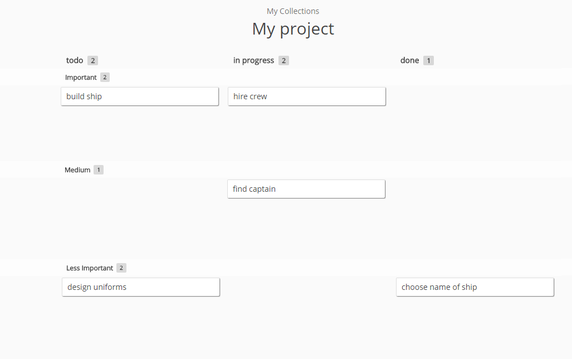The Dark Side of Kanban Boards

Digital Kanban boards are very popular these days. Trello has been a big player in the productivity space for a few years, and now Asana and even GitHub have created their own Kanban views.
It may be time for some theoretical thoughts about these lovable creatures. I recently answered a question on Quora: When should I use labels as opposed to lists? That’s a very good question, and far more interesting than it seems at first glance! Let’s jump down the rabbit hole…
If you’ve found yourself in a situation where you’re confused about how to extend your board, trust me, you are not alone.
Let’s look at this example:

Seems familiar? It doesn’t look good anymore, right? Why is that? It’s because 3 different dimensions are mixed up in one view.
Here are the 3 dimensions:
1. “todo”, ”in progress”, ”done” -> the “stage” of the task / the workflow
2. “Marco” -> assigned member
3. “important” -> a priority

Different dimensions must not be mixed up in one view. Now a card can belong to more than one single list (e.g. “todo” and “Important”)!
That leads to some bad consequences:
1. Confusion, because you don’t know where to add the card.
2. Loss of intuition, because the Kanban board does not represent the real-life situation anymore (it’s “unfair” to some lists).
Let’s call this an unbalanced board. Avoid this at all costs. Just follow the law of disjoint lists. If this law is broken, your board becomes unbalanced.

Why do we get unbalanced boards in the first place?
Of course, you can (and should) represent “Marco” in a member field and “important” as a label. But why do these “bad-guy” lists sometimes magically appear on our boards?
The reason might be primarily psychological:
1. Because you want to move cards from member to member or from priority to priority (Actionable representation).
2. You like to see intuitively how big the stacks of cards are in each list (Proportionality).
So that sounds like a catch-22: We can not break the “law of disjoint lists” but we would like to have more than one actionable dimension. What should be done? This cannot be solved in a one-dimensional tool. We need to switch between our primary dimensions…
Look at our board from above: It has 3 valid and useful views/perspectives:
- By stage:

2. By priority:

3. By member:

4. Even two-dimensional representations are very useful at certain situations:

We started Zenkit because we believe that you can only get rid of these problems by allowing different perspectives! And we realized that this is vital to your project’s long-term success. Within Zenkit you are not limited to one dimension. Imagine if you could see your boards grouped by every possible perspective — in one click.
We can bring back balance to your boards and help you gain great insights. We did not stop here but also discovered that it’s very helpful to be able to switch between Kanban, tables, lists and even mind maps!

Don't let project management be a headache.
Get started with our easy-to-use project management software for free today!
OK, so back to our problem of unbalanced boards. No matter if we have a tool with one or with multi dimension support, we have one more important “law”:

Law of orthogonal dimensions: We should make sure that lists and labels are orthogonal (Orthogonality — Wikipedia) to each other. In real life, that just means: If we choose priorities as labels, every “stage” can be combined with every “priority”, e.g. “todo+medium”, “done+important” etc. Otherwise, we end up with “inconsistent” combinations. E.g. we have the dimension “importance” with values “very”, “medium”, “less” and we have the dimension “urgency” with values “vip”, “medium”, “not urgent”. What does a combination like “less”+”vip” for a card mean? No idea, right? That’s because “importance” and “urgency” are too close to each other — not orthogonal.
FREE 20 MIN. CONSULTATION WITH A PROJECT MANAGEMENT EXPERT
Wanna see how to simplify your workflow with Zenkit in less than a day?
Book a Live Demo